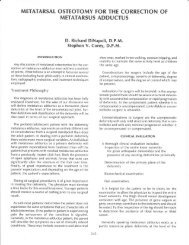anatomic approach to preparation and fusion of the interphalangeal ...
anatomic approach to preparation and fusion of the interphalangeal ...
anatomic approach to preparation and fusion of the interphalangeal ...
Create successful ePaper yourself
Turn your PDF publications into a flip-book with our unique Google optimized e-Paper software.
52CHAPTER 12Figure 2. Representation <strong>of</strong> <strong>the</strong> base <strong>of</strong> <strong>the</strong> middlephalanx. Lateral depressions with central crista forcentering <strong>the</strong> phalanx at <strong>the</strong> articulation.Figure 3A. Collateral ligaments assist in maintainingtransverse plane alignment <strong>and</strong> normal sagittal planejoint tracking.Figure 3B. Collateral ligaments help maintain transverse plane alignment.central projection that tracks within <strong>the</strong> groove formedby <strong>the</strong> proximal phalangeal condyles (Figure 2). Thisarrangement, along with <strong>the</strong> presence <strong>of</strong> a pair <strong>of</strong> collateralligaments that run on ei<strong>the</strong>r side <strong>of</strong> <strong>the</strong> joint restrictsmovement <strong>to</strong> just <strong>the</strong> sagittal plane (Figure 3).Ana<strong>to</strong>mic access <strong>to</strong> <strong>the</strong> joint begins with transversesectioning <strong>of</strong> <strong>the</strong> extensor tendon <strong>and</strong> capsule over <strong>the</strong>dorsum <strong>of</strong> <strong>the</strong> joint. This palpable l<strong>and</strong>mark translates <strong>to</strong> <strong>the</strong>proximal ridge <strong>of</strong> <strong>the</strong> bone-cartilage junction on <strong>the</strong> head <strong>of</strong><strong>the</strong> proximal phalanx. The medial <strong>and</strong> lateral collateralligaments are <strong>the</strong>n divided, completing <strong>the</strong> disarticulation<strong>and</strong> exposing <strong>the</strong> head <strong>of</strong> <strong>the</strong> proximal phalanx. A smallamount <strong>of</strong> fur<strong>the</strong>r dissection <strong>of</strong> <strong>the</strong> capsular attachments <strong>and</strong>adjacent periosteum may be required for full degloving in<strong>preparation</strong> for joint ressection. This leaves a small flap <strong>of</strong>tissue over both <strong>the</strong> head <strong>of</strong> <strong>the</strong> proximal phalanx <strong>and</strong> base<strong>of</strong> <strong>the</strong> middle phalanx. These are usually clamped <strong>and</strong>retracted with a mosqui<strong>to</strong> hemostat.Arthrodesis requires cartilage removal from adjacentsides <strong>of</strong> <strong>the</strong> joint, removal <strong>of</strong> <strong>the</strong> subchondral bone plate,<strong>and</strong> approximation <strong>and</strong> rigid fixation throughout <strong>the</strong> phases<strong>of</strong> bone healing. When performing an arthrodesis <strong>the</strong>re area few general principles <strong>to</strong> follow. First, exposure <strong>of</strong> <strong>the</strong>cancellous bone material is critical <strong>to</strong> <strong>fusion</strong>. Incompletetissue removal during <strong>the</strong> operation is possibly <strong>the</strong> leadingcause <strong>of</strong> nonunion. However, aggressive bone resection canFigure 4. The typical resection includes <strong>the</strong> entirety<strong>of</strong> articular cartilage back <strong>to</strong> <strong>the</strong> flare <strong>of</strong> <strong>the</strong>metaphysis on <strong>the</strong> respective sides <strong>of</strong> <strong>the</strong> proximal<strong>and</strong> middle phalanges as depicted by <strong>the</strong> red lines.leave a digit short or render <strong>the</strong> tendinous structures unable<strong>to</strong> move <strong>the</strong> <strong>to</strong>e, resulting in a flail <strong>to</strong>e. The digital lengthshould represent a parabola, or unbroken arc with respect<strong>to</strong> adjacent digits. Second, joint apposition is critical <strong>to</strong>successful osseous bridging. The prepared joint ends must bein contact, preferably along <strong>the</strong> entire surface <strong>of</strong> <strong>the</strong> boneends, <strong>to</strong> achieve <strong>fusion</strong>. Third, <strong>ana<strong>to</strong>mic</strong> alignment isimportant for both function <strong>and</strong> cosmesis. The <strong>fusion</strong> shouldleave <strong>the</strong> <strong>to</strong>e neutral on <strong>the</strong> frontal plane, neutral <strong>to</strong> slightlyflexed on <strong>the</strong> sagittal plane, <strong>and</strong> parallel with adjacent digitson <strong>the</strong> transverse plane. Finally, <strong>the</strong> choice <strong>of</strong> fixation mustmake sound biomechanical sense, maintaining <strong>the</strong> bone endsin alignment against <strong>the</strong> two main deleterious forces:distraction <strong>and</strong> plantarflexion. Use <strong>of</strong> poor fixation methodsor failure <strong>to</strong> maintain bone apposition for long enough willlikely result in pos<strong>to</strong>perative complications.
















